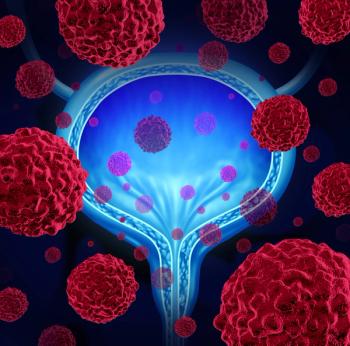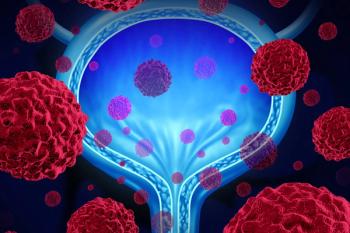
Oncology NEWS International
- Oncology NEWS International Vol 10 No 11
- Volume 10
- Issue 11
New Bladder Cancer Treatments Increase Life Expectancy in Advanced Bladder Cancer
ANAHEIM, California-A phase III Intergroup trial has provided strong evidence that neoadjuvant MVAC-methotrexate, vinblastine, doxorubicin (Adriamycin), cisplatin (Platinol)-provides a survival benefit in patients with locally advanced bladder cancer, David Crawford, MD, said at the American Urological Association (AUA) annual meeting (abstract 1069).
ANAHEIM, CaliforniaA phase III Intergroup trial has provided strong evidence that neoadjuvant MVACmethotrexate, vinblastine, doxorubicin (Adriamycin), cisplatin (Platinol)provides a survival benefit in patients with locally advanced bladder cancer, David Crawford, MD, said at the American Urological Association (AUA) annual meeting (abstract 1069).
Dr. Crawford is professor of urologic oncology, University of Colorado Cancer Center, Denver. [The study, not previously reported in ONI, was also presented at the 2001 ASCO annual meeting plenary session (abstract 3).]
Although cystectomy and removal of surrounding lymph nodes provides the best survival benefit for patients with advanced bladder cancer, about 60% of these patients harbor micrometastases and die of their disease. The only therapy that has proved superior to cisplatin alone in patients with grossly advanced metastatic disease is MVAC.
Neoadjuvant MVAC
This study, by SWOG, ECOG, and CALGB, aimed to determine if three cycles of MVAC followed by cystectomy would improve survival in patients treated at an earlier stage. SWOG 8710 (Intergroup 0080) was a randomized phase III trial of neoadjuvant MVAC followed by cystectomy vs cystectomy alone in 307 patients evaluated over a 14-year period. Patients had T2-4a, N0, M0 transitional cell carcinomas and were stratified according to age and stage.
Dr. Crawford reported that survival was 2.4 years longer for patients receiving neoadjuvant MVAC, compared with those who underwent surgery alone. With median follow-up of 7.1 years, 128 patients remain alive, with 85 and 94 deaths, respectively, in the MVAC and no MVAC arms. Estimated median survivals are 6.2 years and 3.8 years, respectively, and the hazard ratio is 0.74 for patients receiving MVAC (P = .027).
Additionally, pathologic examination of the bladder after cystectomy revealed that 38% of patients receiving MVAC had no evidence of remaining disease. Among these patients, 85% were still alive 5 years after surgery.
"This is the first clinical trial to demonstrate a statistically significant and clinically meaningful improvement in survival with preoperative chemotherapy," Dr. Crawford said. "The remarkable survival of the 38% of patients who achieved complete eradication of their bladder cancer provides a strong rationale to consider a bladder-sparing approach to treating this disease."
Grade 4 toxicities occurred in 37% of MVAC-treated patients. Neutropenia accounted for the vast majority of these cases; however, only one patient developed febrile neutropenia. There were no chemotherapy-associated deaths, and MVAC did not affect the incidence or severity of surgical complications.
Future clinical trials may examine whether MVAC alone, or one of the newer drug combinations, is sufficient treatment for some patients with advanced bladder cancer, he said.
Survival in Women vs Men
Recent publications based on large population studies have suggested that women with invasive bladder cancer have an overall worse prognosis than men after radical cystectomy. To examine this question, researchers from the University of Southern California retrospectively analyzed results from a 10-year cohort of patients with transitional cell carcinoma of the bladder followed from 1989 through 1998 (AUA abstract 1064).
Eila C. Skinner, MD, reported no differences in survival between men and women when patients with localized invasive bladder cancer are treated in a uniform manner with radical cystectomy.
The study was based on a cohort of 526 patients. Women and men appeared clinically similar. More men were smokers and had received preoperative systemic chemotherapy, and more women had received intravesical chemotherapy. None of these differences were statistically significant.
Five-year overall survival was 63.5% for women and 58.9% for men. Recurrence-free survival was 69.1% and 71.7%, respectively, she reported.
Importance of Stratification
Another large retrospective study presented at the AUA meeting attempted to determine long-term predictors of survival after radical cystectomy for bladder cancer (abstract 1065). The study was based on 686 patients undergoing radical cystectomy and lymph node dissection from 1980 to 1990 at Memorial Sloan-Kettering Cancer Center.
In this study, patients with organ-confined bladder cancer had high disease-specific survival rates following radical cystectomy, reported Jürgen E. Gschwend, MD, University of Ulm, Germany, and William R. Fair, MD, of Memorial Sloan-Kettering.
Ten-year disease-specific survival was 75% for patients with organ-confined disease vs 50% for non-organ-confined disease (P = .001). Overall survival rates, respectively, were 43% and 28% (P = .022). In node-positive patients, 10-year disease-specific and overall survival rates were 28% and 21% months, respectively.
The poor prognosis of patients with non-organ-confined and/or node-positive tumors emphasizes the importance of stratification in future randomized trials, the authors said.
Articles in this issue
about 24 years ago
Two Large AIDS Studies Will Increase Enrollments 60%about 24 years ago
Gene Therapy Plus Radiotherapy Delays Esophageal Cancer Growth in Miceabout 24 years ago
Platinum-Based Regimens Are Favored in Advanced NSCLCabout 24 years ago
Radiofrequency Ablation Proving Effective in Small Renal Cell Tumorsabout 24 years ago
Templates Used to Document Chemotherapyabout 24 years ago
Grade Dictates Treatment of Primary NHL of the Breastabout 24 years ago
Low Arsenic Levels in Drinking Water Increase Cancer Riskabout 24 years ago
Astatine-211-Labeled MoAB Promising in Brain Cancer Patientsabout 24 years ago
GEMOX Active With Low Toxicity in Pancreatic Cancerabout 24 years ago
Legislation Urged to Revitalize the National Cancer PlanNewsletter
Stay up to date on recent advances in the multidisciplinary approach to cancer.

















































































